Simple Cottage Cheese Flatbread Recipe Packed with Flavor
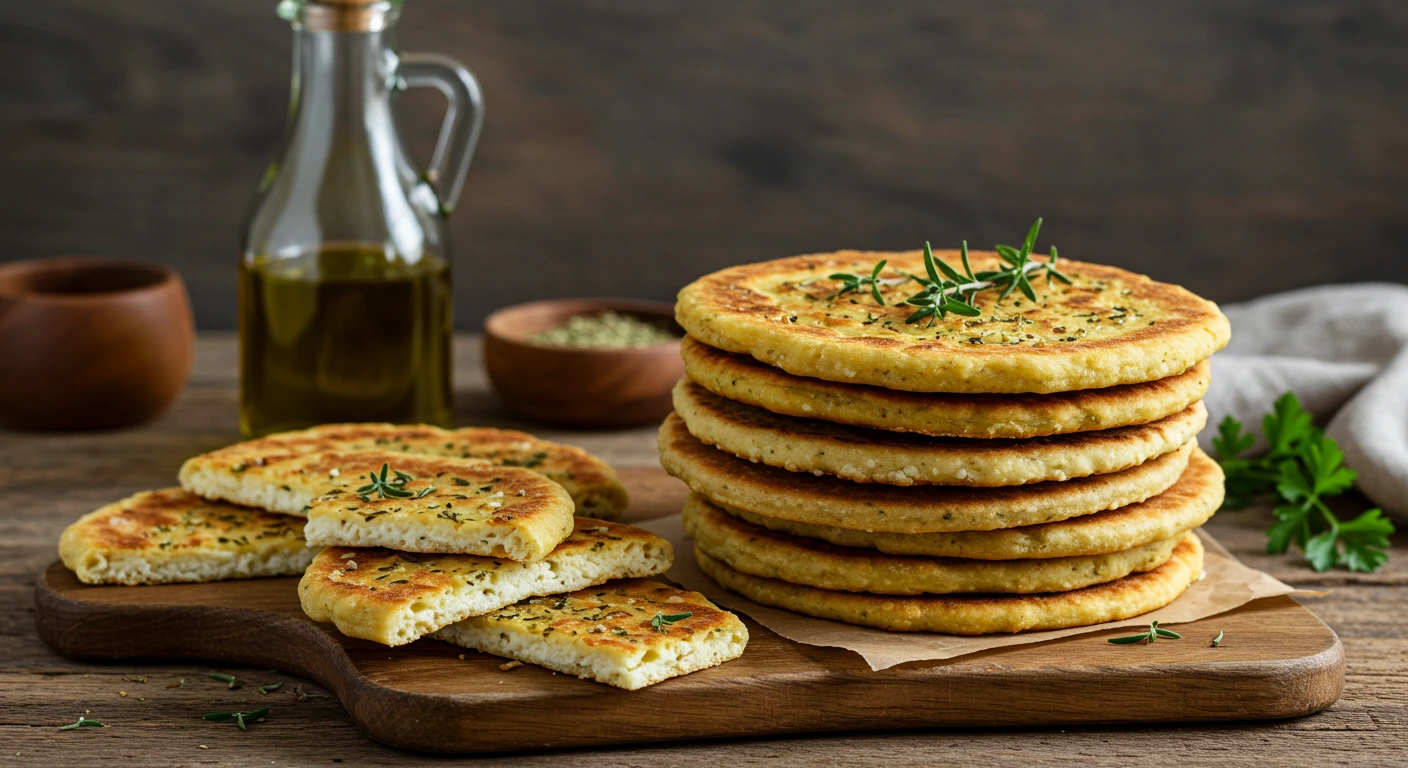
Table of Contents
Introduction to Cottage Cheese Flatbread
If you’ve been hunting for a quick, protein-packed bread alternative that’s forgiving, tasty, and downright useful in the kitchen, this cottage cheese flatbread recipe is the kind of find that feels like discovering a secret shortcut. Think of it as the culinary equivalent of a Swiss Army knife: it wraps lunches, holds soups, becomes a crispy pizza base, or simply satisfies a mid-afternoon nibble.
What makes this flatbread different? Instead of relying on long-rise doughs, yeast, or complicated fermentation, it leans on cottage cheese and eggs (and optionally a bit of flour or flour substitute) to create a tender, elastic dough. That’s why you’ll see it described as a cottage cheese and egg flatbread, a cottage cheese egg flatbread, or — when you want to get impressively minimal — a cottage cheese 2 ingredient flatbread. Each name highlights the same advantage: simplicity without sacrificing flavor.
So why read on? Because I’ll show you how to make a version that’s soft in the middle, slightly crisp at the edges, and packed with savory notes from garlic, olive oil, and herbs. You’ll also learn how to adapt it for low-carb, gluten-free, or high-protein needs. Ready? Let’s get into the ingredients and the why behind them.
Why You’ll Love This Cottage Cheese Flatbread Recipe
Why is this recipe getting all the attention? A few reasons:
- High-protein and satisfying — Cottage cheese brings a rich protein hit that keeps hunger at bay. If you’re looking for a high protein flatbread or a bread substitute that supports muscle repair and satiety, this is a smart choice.
- Fast and forgiving — No kneading for ages, no proofing. The mixing takes minutes; cooking takes a little longer. This is essentially a no yeast flatbread recipe that performs like a real bread.
- Versatile — Use it as a wrap, a pizza base, a sandwich bread, or a snack. Its neutral tang pairs well with everything from roasted veggies to smoked salmon.
- Diet friendly — Easily made gluten-free with almond or chickpea flour; suitable for many low-carb or keto-ish meal plans when tweaked. It’s an excellent low carb flatbread recipe alternative.
Think of this flatbread like a blank canvas: cottage cheese provides the creamy, tangy texture while eggs and your chosen flour hold everything together. Add herbs and spices, and you’ve got a loaf of flavor that bakes in under 20 minutes. It’s simple, but it’s not bland.
Ingredients You’ll Need
Below is a clear table of ingredients for the base recipe and suggested swaps that match different diets (gluten-free, low-carb, etc.). Presenting the ingredients this way makes it easy to scan and substitute.
| Ingredient | Amount | Purpose / Notes |
|---|---|---|
| Cottage cheese (full-fat or low-fat) | 1 to 1½ cups | Base binder and protein source; blend for smoother texture |
| Eggs | 2 large | Coagulates and gives structure — the “egg” in cottage cheese egg flatbread |
| All-purpose flour (or almond/chickpea flour) | ¾ – 1 cup | Adjust for consistency; almond flour for gluten-free/low-carb |
| Baking powder | 1 tsp | Optional — adds slight lift; omit for true 2-ingredient version |
| Salt | ½ tsp | Enhances flavor |
| Garlic powder or minced garlic | ½ tsp (or 1 clove) | Flavor builder |
| Dried herbs (oregano, basil) or fresh parsley | 1–2 tsp | Aroma and taste |
| Olive oil | 1–2 tbsp | For richness and to help crisp edges |
| Optional add-ins: grated cheese, chopped spinach, sun-dried tomatoes | As desired | Personalize toppings and mix-ins |
Note: For a true cottage cheese 2 ingredient flatbread, use only cottage cheese and eggs — blend them until smooth, then pan-fry in small rounds. The texture will be less dough-like but still bread-like and very quick.
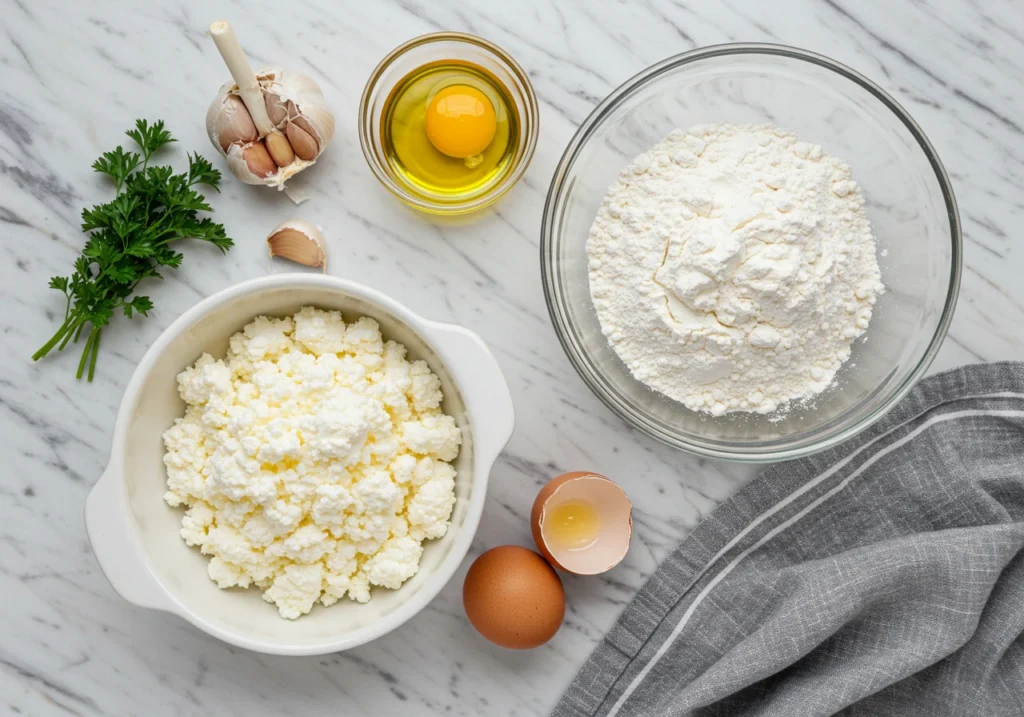
Kitchen Tools for Cottage Cheese Flatbread
An organized tool list speeds the job up. Below is what I use most frequently.
| Tool | Why it helps |
|---|---|
| Mixing bowl or food processor | A food processor yields the smoothest texture; a bowl + whisk works too |
| Spatula | For folding and scraping |
| Non-stick skillet or cast-iron skillet | For stovetop cooking — gives a great crust |
| Baking tray and parchment paper | For oven-baked versions and easier cleanup |
| Rolling pin (optional) | For shaping if you want uniform thickness |
| Measuring cups and spoons | Accuracy matters with flour substitutes |
| Oven or stovetop | Your choice for cooking method |
If you have a food processor, use it to blend the cottage cheese until silky — that creates a dough that’s noticeably more cohesive and less grainy. If not, a vigorous whisk or immersion blender works fine.
Step-by-Step Cottage Cheese Flatbread Recipe
Below I’ll walk you through a clear, flexible method that works whether you aim for an oven-baked flatbread or a quick skillet version. This section covers the cottage cheese and egg flatbread base, shaping, and cooking.
Mixing the Dough (cottage cheese + eggs base)
- Blend the cottage cheese: Put 1 to 1½ cups of cottage cheese in a food processor and pulse until smooth. If you don’t have a processor, put it in a bowl and mash with a fork or use an immersion blender. The smoother the cottage cheese, the fewer lumps in your final bread.
- Add eggs and seasonings: Crack 2 large eggs into the smooth cottage cheese. Add ½ tsp salt, ½ tsp garlic powder (or 1 minced clove), and 1–2 tsp dried herbs. Pulse or whisk until fully combined. This is your basic cottage cheese and egg flatbread batter.
- Incorporate flour or substitute: Gradually add ¾ cup of all-purpose flour or ½–¾ cup of almond flour for a gluten-free, lower-carb version. You’re aiming for a thick batter that holds a spoonful without running off — more like a soft cookie dough than pancake batter.
- If you want a cottage cheese 2 ingredient flatbread, skip the flour. The result will be tender and slightly more delicate — treat it like a large, savory pancake.
Pro tip: Let the mixture rest 5–10 minutes. This gives flour alternatives a chance to absorb moisture, which makes the dough easier to shape.
Shaping and Preparing
- Preheat your skillet or oven: If using a skillet, sear on medium-high heat with a little oil. If baking, preheat oven to 200°C (400°F) and line a tray with parchment.
- Divide and shape: Use a spoon to portion dough into 4–6 rounds for medium flatbreads. If the dough is sticky, wet your hands lightly and pat each portion into a round about ¼-inch thick. For uniform thickness, place between two sheets of parchment and roll gently with a rolling pin.
- Brush with olive oil: A thin brush of olive oil on top helps with browning and flavor — it’s like giving the flatbread a golden tan.
Cooking Method — Baking vs. Stovetop Skillet
- Skillet method (quick and slightly crisp edges):
- Heat a non-stick or cast-iron skillet over medium heat with 1 tsp olive oil.
- Place shaped rounds in the pan and cook 3–4 minutes per side, pressing gently with a spatula to ensure even contact.
- Finished flatbreads should be golden brown with a slightly springy center.
- Oven method (crispy, evenly baked):
- Place rounds on a parchment-lined baking tray.
- Bake at 200°C (400°F) for 12–15 minutes, flipping halfway through for even color.
- For an extra-crispy finish, broil for 1–2 minutes at the end — watch closely.
How to know it’s done: The edges will be golden and the center set. If you press the middle lightly, it should rebound rather than feel liquid. If you used almond flour, the texture will be slightly denser and more tender; all-purpose flour gives a more familiar bread bite.
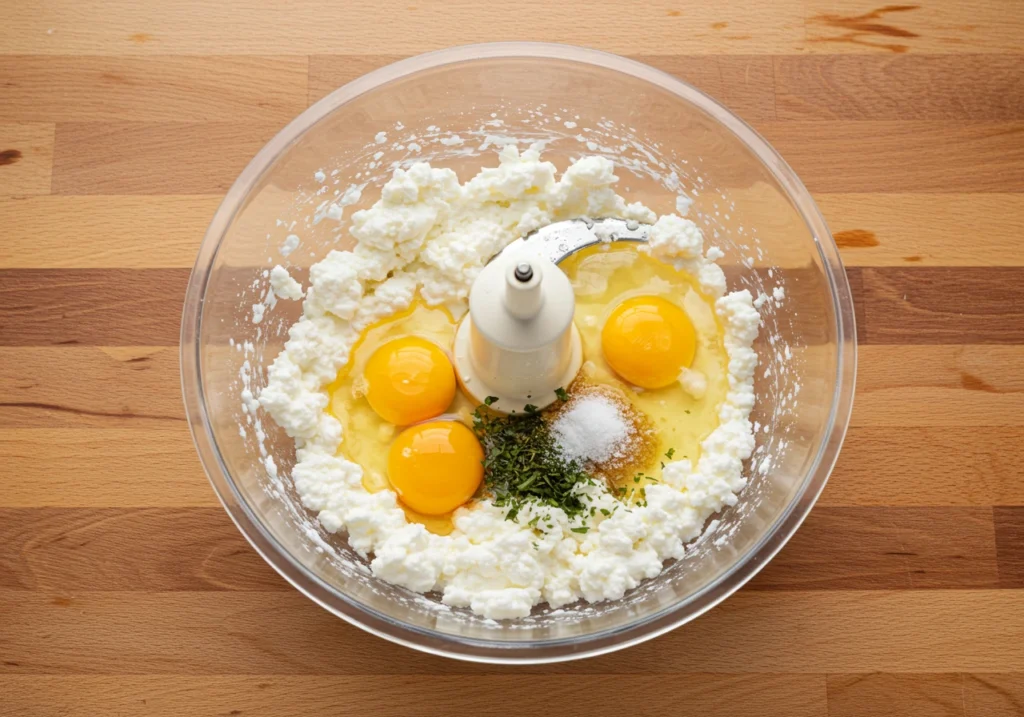
Flavor Tips While You Mix
Want it cheesy? Fold in ¼ cup grated Parmesan or cheddar. Want more herbs? Fresh parsley or chives folded in at the end give a bright pop. Want to add veggies? Squeeze out excess moisture from grated zucchini before folding it in — too much water will make dough soggy.
A quick analogy: if traditional bread is a symphony that requires rehearsal and an orchestra, this flatbread is a talented soloist — small, nimble, and plenty of personality.
Variations of Cottage Cheese Flatbread
One of the biggest advantages of this recipe is how flexible it can be. Depending on your diet, time, or cravings, you can transform the base into something that fits perfectly. Let’s explore a few standout versions.
Cottage Cheese 2 Ingredient Flatbread
This version is as simple as it sounds — just cottage cheese and eggs. Blend them together until smooth, then pour small rounds of batter into a skillet and cook until firm. The result isn’t chewy like traditional bread
Cottage Cheese Egg Flatbread
Think of this as the protein-packed breakfast version. Add a touch of almond flour to the cottage cheese and egg mixture, then cook as a skillet bread. It holds its shape better than the two-ingredient version, making it perfect for sandwiching scrambled eggs, avocado, or smoked salmon. It’s also an excellent substitute for toast if you’re steering clear of bread.
Gluten-Free Flatbread
If gluten isn’t your friend, replace the all-purpose flour with almond flour, chickpea flour, or even oat flour. Almond flour gives a nutty, rich taste and keeps carbs low. Chickpea flour adds a little earthiness and more structure. Oat flour strikes a balance with mild flavor and better elasticity. Each option creates a slightly different vibe, but all remain true to the cottage cheese flatbread recipe concept.
Tips for Perfect Flatbread Every Time
Flatbread recipes sound easy — and they are — but a few insider tricks can turn a good result into a great one.
- Avoid excess moisture: Cottage cheese can sometimes release water. Blending helps, but if it seems too wet, drain it through a fine sieve for 10–15 minutes before mixing.
- Don’t skip the resting stage: Giving the batter or dough a few minutes to rest lets flour (or almond flour) absorb liquid, which reduces stickiness and improves texture.
- Use medium heat for skillet cooking: Too high and the outside burns while the inside stays raw. Too low and you’ll end up steaming instead of browning.
- Season generously: Salt, herbs, and spices are your friends. Flatbread is a blank canvas, so flavor it up with garlic, paprika, rosemary, or even chili flakes.
- Thin is better than thick: Roll or spread the dough no thicker than ¼ inch. Thin flatbread cooks evenly and gets that chewy-but-crisp balance.
Serving Suggestions for Cottage Cheese Flatbread
So, you’ve pulled a golden-brown stack of flatbreads from the pan. Now what? Here are a few ways to enjoy them.
As a Side Dish
Serve with hearty soups, like tomato or lentil. Pair with curries or stews for a lighter alternative to naan. It’s also excellent alongside grilled meats or roasted veggies.
As a Wrap or Sandwich
Fill it with roasted vegetables, grilled chicken, or falafel. The pliability makes it a great lunch wrap. Want something quick? Spread hummus, add cucumber slices, and roll it up.
As a Pizza Base
This one’s a crowd-pleaser. Use the flatbread as a quick pizza crust: spread tomato sauce, sprinkle cheese, and top with vegetables. Bake for a few minutes until melted and bubbly. Dinner is ready in under 15 minutes.
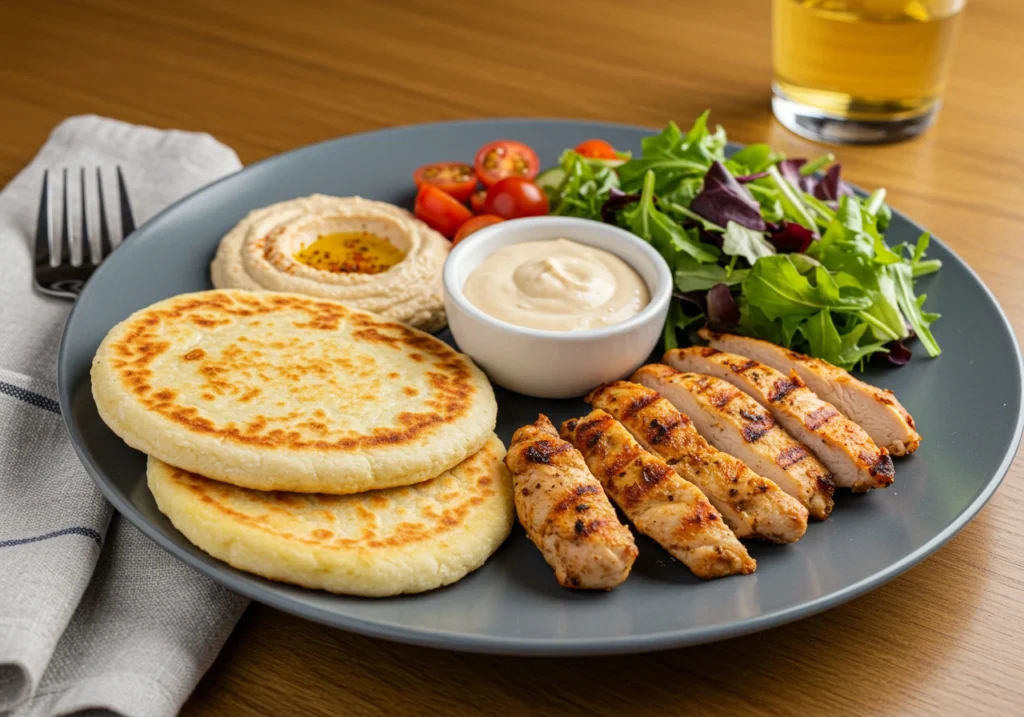
Storage and Reheating Tips
Flatbread is best fresh, but with the right approach, you can keep it around for later.
- Fridge storage: Wrap cooled flatbreads in parchment and store in an airtight container for up to 3 days.
- Freezing: Stack flatbreads with parchment between each, then freeze in a zip-top bag. They’ll keep for up to a month.
- Reheating: Use a dry skillet for best results. A few minutes on medium heat revives crispness without drying it out. An oven at 350°F works too. Microwave only if you’re in a rush — it tends to soften the texture too much.
Nutritional Benefits of Cottage Cheese Flatbread
Why swap regular bread for this recipe? Because it offers nutrition perks without feeling like a compromise.
High-Protein Powerhouse
Cottage cheese and eggs deliver a double punch of protein, helping with muscle repair and keeping you fuller for longer. Compared to traditional flatbread, this one has nearly double the protein content.
Low-Carb Alternative
If you use almond or chickpea flour, you’ll slash carbs dramatically. This makes it suitable for low-carb and keto lifestyles while still giving you that bread-like satisfaction.
Rich in Vitamins and Minerals
Cottage cheese provides calcium for strong bones, vitamin B12 for energy, and selenium, a mineral linked to better immunity. Combine that with the fiber from flour substitutes like oat or chickpea, and you’ve got a balanced, nutrient-dense option.
FAQs About Cottage Cheese Flatbread Recipe
Can I make this without eggs?
Yes — though eggs give structure. Try flaxseed meal mixed with water (1 tbsp flax + 3 tbsp water per egg) as a vegan-friendly binder.
Is this recipe keto-friendly?
It can be. Skip the all-purpose flour and go for almond or coconut flour. Stick to the cottage cheese 2 ingredient flatbread version for the lowest carbs.
What flour substitutes can I use?
Almond, chickpea, oat, or coconut flour all work. Each will give slightly different flavors and textures, but they’re all worth experimenting with.
Can I add sweet flavors?
Absolutely. Skip the garlic and herbs, and instead mix in cinnamon and a touch of honey or vanilla. You’ll get a breakfast flatbread that pairs beautifully with fruit or nut butter.
Conclusion: Enjoy This Healthy & Flavorful Flatbread
The beauty of this cottage cheese flatbread recipe is that it doesn’t lock you into one version. Whether you go minimal with the cottage cheese and egg flatbread, quick with the 2 ingredient method, or dress it up with herbs, spices, and flour substitutes, the result is always satisfying. It’s flexible, nutrient-dense, and fast — the holy trinity of weeknight cooking.
Think of it as your new go-to bread alternative. You can use it to mop up curries, wrap around lunch fillings, or transform into a personal pizza base. It keeps well, reheats beautifully, and adapts to just about any diet.
So, the next time you want bread without the fuss, remember this flatbread. It’s proof that sometimes the simplest recipes are the ones you’ll come back to again and again.
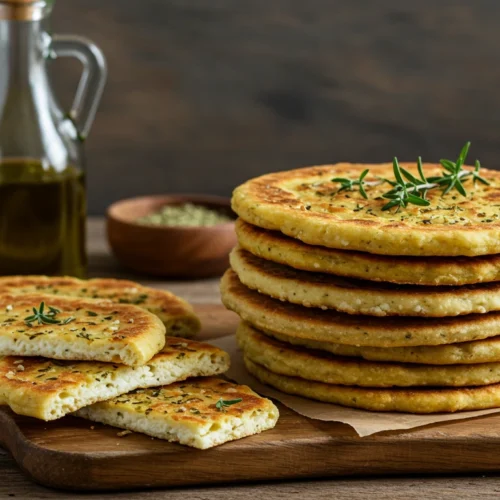
Simple Cottage Cheese Flatbread Recipe Packed with Flavor
Ingredients
- 1 to 1½ cups cottage cheese full-fat or low-fat
- 2 large eggs
- ¾ to 1 cup all-purpose flour or almond flour or chickpea flour for gluten-free
- 1 teaspoon baking powder optional, for extra lift
- ½ teaspoon salt adjust to taste
- ½ teaspoon garlic powder or 1 minced garlic clove
- 1 to 2 teaspoons dried herbs oregano, basil, or parsley
- 1 to 2 tablespoons olive oil
- Optional: grated cheese chopped spinach, or sun-dried tomatoes for variety
Instructions
- Blend cottage cheese in a food processor or whisk until smooth.
- Mix in eggs, salt, garlic, and herbs until well combined.
- Stir in flour (or almond/chickpea flour) gradually until dough forms. For a 2-ingredient flatbread, skip flour.
- Rest batter for 5–10 minutes to allow absorption and reduce stickiness.
- Preheat oven to 400°F (200°C) or heat a skillet with olive oil on medium.
- Divide and shape dough into 4–6 rounds (¼ inch thick).
- Brush tops with olive oil for flavor and browning.
- Cook in skillet for 3–4 minutes per side until golden OR bake for 12–15 minutes, flipping halfway.
- Serve warm as a wrap, pizza base, or side dish.
Notes
- 2-Ingredient Flatbread: Only cottage cheese and eggs → pan-cooked like savory pancakes.
- Gluten-Free Version: Use almond or chickpea flour instead of wheat flour.
- Cheesy Upgrade: Add ¼ cup grated Parmesan or cheddar to dough.
- Herb Boost: Fresh parsley, rosemary, or chives add brightness.
- Sweet Option: Skip garlic/herbs, add cinnamon and vanilla for a breakfast-style flatbread.
Review Our Recipe: Your Feedback Makes a Difference
There are no reviews yet. Be the first one to write one.
